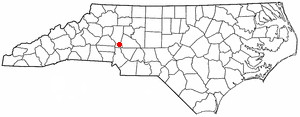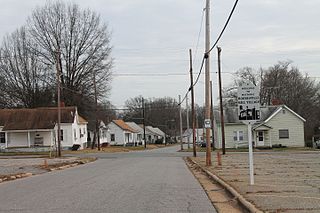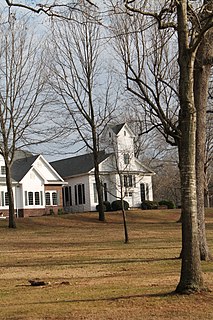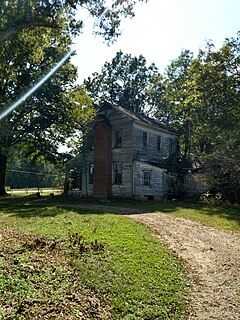
Mooresville is a large town located in south western section of Iredell County, North Carolina, United States and is a part of the fast-growing Charlotte Metro area. The population was 32,711 at the 2010 United States Census. In 2019, the population had increased to 39,132, making it the largest municipality in Iredell County. It is located approximately 25 miles (40 km) north of Charlotte.

Logan Circle is a traffic circle park, neighborhood, and historic district in the Northwest quadrant of Washington, D.C. The primarily residential neighborhood includes two historic districts, properties listed on the National Register of Historic Places, and sites designated D.C. Historic Landmarks. Vermont Avenue NW, Rhode Island Avenue NW, 13th Street NW, and P Street NW meet at the circle. An equestrian statue of Major General John A. Logan stands at its center. It is the only major circle downtown that remains entirely residential.

Mooresville Mill Village Historic District is a national historic district located at Mooresville, Iredell County, North Carolina. It was listed on the National Register of Historic Places in 2012.
Broad Street Historic District and variations with Commercial as well as with North, South, East and West may refer to the following places in the United States listed on the National Register of Historic Places:

St. Michael's Episcopal Church is a historic church and the oldest surviving religious structure in Charleston, South Carolina. It is located at Broad and Meeting streets on one of the Four Corners of Law, and represents ecclesiastical law. It was built in the 1750s by order of the South Carolina Assembly. It is listed on the National Register of Historic Places and is a National Historic Landmark.

The Governor John Rutledge House is a historic house at 116 Broad Street in Charleston, South Carolina. Completed in 1763 by an unknown architect, it was the home of John Rutledge, a Governor of South Carolina and a signer of the United States Constitution. It was declared a National Historic Landmark in 1973.

Coddle Creek Associate Reformed Presbyterian Church, Session House and Cemetery is a historic Associate Reformed Presbyterian church located near Mooresville in Iredell County, North Carolina, United States.

Centre Presbyterian Church, Session House and Cemeteries is a historic Presbyterian church, session house, and cemetery located near Mount Mourne, Iredell County, North Carolina. The original church building was constructed in 1765, but was destroyed by fire. The current church building and session house were constructed 1854. The church is a one-story, three bay by four bay, rectangular vernacular Greek Revival style brick church. The church's cemetery contains gravestones dating to the 18th century.

Mooresville Historic District is a national historic district located in Mooresville, Iredell County, North Carolina. It encompasses 62 contributing buildings and 8 contributing sites in the central business district and surrounding residential sections of Mooresville. The district includes notable examples of Italianate, Romanesque Revival, and Renaissance Revival architecture. Notable buildings include the Mooresville depot, the former Lorene Cotton Seed Oil Mill, First Presbyterian Church (1899), McLelland House, D. E. Turner Hardware Co. store, the former U. S. Post Office, and the McKnight Pontiac-Buick Co..

The Espy Watts Brawley House, also known as the Brawley House, is a historic home located at Mooresville, Iredell County, North Carolina. It was built in 1904, and is a large 2 1/2-story, transitional Queen Anne / Colonial Revival style frame dwelling. It has a two-story side wing with a two-story, three-sided bay; truncated slate hipped roof; and one-story wraparound porch with porte-cochère. Also on the property are two contributing outbuildings.

The George Houston House, also known as the "Wall-Houston House", is a private historic home between Mooresville and Davidson, North Carolina in Iredell County that was built in 1818. The original portion of the home was built with log construction, and several later additions, including a 19th-century ell. In its nomination, the home's original Federal-style construction was noted as being highly representative of the idiosyncrasies found in home designs in Iredell County and the North Carolina Piedmont during the Federal era. The property on which the home sits also contains several historic outbuildings, including an early log barn.

South Broad–East Fifth Streets Historic District is a national historic district in Burlington, Alamance County, North Carolina. It encompasses 108 contributing buildings in a primarily residential section of Burlington. Most of the buildings are houses, one to two stories high, built between the 1890s and the 1940s in late Victorian, Queen Anne, American Craftsman, and Colonial Revival styles of frame or brick construction.

Milton Historic District is a national historic district located at Milton, Caswell County, North Carolina. It encompasses 15 contributing buildings in the town of Milton. The district includes notable examples of Federal and Greek Revival style architecture. In addition to the separately listed Milton State Bank and Union Tavern, other notable buildings include the Clay-Lewis-Irvine House, Winstead House, Presbyterian Church, Baptist Meeting House, Old Shops, Old Stores, and row houses. Fittings in the Presbyterian Church and Baptist Meeting House are attributed to noted African-American cabinetmaker Thomas Day.

Dr. J. Howell Way House is a historic home located at the south end of Main Street Waynesville, Haywood County, North Carolina. The beautiful brick home was once a modest smaller brick home owned by the Welch family, relatives of Robert love the father of Waynesville. The original home pre dates the civil war and parts of the current structure dates to before the war. In 1888 Dr. J. Howell Way, a prominent physician, married Marietta Welch and in 1894 the small home was acquired, along with an 11-acre tract of land. Soon after dr. Way built a medical office and by 1899 had completed one of the areas most distinguished homes. The home is a large 3 1/2 story brick dwelling retaining a lot of the woodwork, large carved fireplaces, and grand staircase with Queen Anne and Colonial Revival style design elements. It also features a full attic and widow's walk on the very top of the structure. It has a complex roof system composed of a broad hip broken with projecting gables and shed dormers; a one-story, hip roof front wraparound porch and second floor balcony; porte-cochère, and a projecting three-sided, two story bay. Also on the property are the contributing medical office and carriage house.

Cornelius House is a historic home located near Mooresville, Iredell County, North Carolina. The house was built about 1825, and is a tripartite Federal style, "T"-shaped frame dwelling with a two-story central section flanked by one-story wings. It has a gable roof, fieldstone foundation, and a single shouldered brick end chimneys.

East Broad Street–Davie Avenue Historic District is a national historic district located at Statesville, Iredell County, North Carolina. It encompasses 65 contributing buildings in a predominantly residential section of Statesville. The district includes notable examples of Late Victorian architecture and were mainly built between about 1880 and 1930. Notable buildings include the Elma Apartments building, Matt-Simons House, J. S. Ramsey House, and Major H. L. Allison House.

Mitchell College Historic District is a national historic district located at Statesville, Iredell County, North Carolina. It encompasses 336 contributing buildings and 1 contributing site associated with Mitchell Community College and the surrounding residential area in Statesville. The district includes notable examples of Greek Revival, Queen Anne, and Classical Revival architecture dated between about 1885 and 1930. Located in the district is the oldest building and separately listed; the Main Building, Mitchell College (1854-1856). Other notable contributing resources are the Fourth Creek Burying Ground, George Anderson House, Friends Meeting House, Broad St. Methodist Church (1907), Congregation Emmanuel Synagogue (1891), McRorie House, Dr. Tom H. Anderson House, Dr. Julius Lowenstein House, Ludwig Ash House, L. N. Mills House (1925), Mills Apartment, R. A. Cooper House (1920), Statesville Woman's Club (1927), and the former Davis Hospital.

Marshall Main Street Historic District is a national historic district located at Marshall, Madison County, North Carolina. It encompasses 40 contributing buildings in the central business district of Marshall. It includes notable examples of Classical Revival architecture and buildings dating the mid-19th century through 1950. Located in the district are the separately listed Bank of French Broad designed by James J. Baldwin and Madison County Courthouse designed by Smith & Carrier. Other notable buildings include the Rock Café Restaurant (1947), Colonel Lawrence M. Allen House, M. E. Church South (1912), O.C. Rector Building (1928), and Tweed's Department Store.

Gen. William H. Kerr House is a historic home located on Deal Road, near Enochville, Rowan County, North Carolina.




















